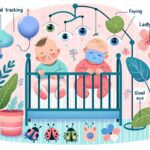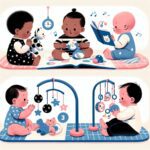Tracking and supporting newborn visual development is a critical part of understanding and nurturing your baby’s growing senses. From the moment they open their eyes to the world, newborns embark on a visual journey, learning to focus, track movement, and eventually recognize faces and objects. This article delves deep into the strategies and activities parents can employ to aid their infants’ visual development, ensuring a strong foundation for their sensory growth.
The Importance of Early Visual Development
Visual skills are among the first ways a baby starts to understand their environment. From birth, babies begin to develop the abilities necessary for visual tracking, depth perception, and color recognition. This early stage is not just about seeing but about forming the visual building blocks that support other areas of development, such as motor skills and cognitive growth. Acknowledging the significance of these early experiences is the first step in supporting your child’s visual development journey.
Research suggests that providing a stimulating environment with varying patterns and colors can enhance visual development. A study by the American Optometric Association highlights the need for age-appropriate toys and activities that encourage visual tracking and focus. Furthermore, regular check-ups with a pediatric optometrist can ensure that any potential visual impairments are identified and addressed early, supporting optimal visual health and development. For more insights on nurturing your baby’s visual skills, click here.
Tracking and Supporting Newborn Visual Development
Monitoring your newborn’s visual development involves observing their ability to track moving objects, focus on faces, and react to bright colors or patterns. During the first few months, babies gradually gain the ability to follow objects with their eyes, a key milestone in visual tracking. Parents can support this development by engaging their babies in simple activities such as moving a colorful toy back and forth in their line of sight and allowing ample tummy time to strengthen neck muscles for better head control and visual exploration.
Incorporating activities that promote visual tracking and focus is beneficial. For instance, gently swinging a brightly colored object or using mobiles with high-contrast patterns can stimulate your baby’s visual tracking skills. Additionally, ensuring your baby has the opportunity to look at a variety of shapes and colors can aid in their visual differentiation skills. For more activities that boost fine motor skills, which are closely linked to visual development, visit this resource.
Advanced Strategies for Enhancing Visual Development
As your baby grows, their visual development needs become more complex. Introducing interactive play that encourages visual tracking and hand-eye coordination is essential. Activities like playing peek-a-boo, rolling a ball back and forth, and using toys that move and make sounds can further refine their visual skills. Reading books with large, colorful pictures not only aids in visual development but also begins to lay the groundwork for language and emotional connection.
Consider setting up a play area at home that includes a variety of visually stimulating objects and toys. This designated space can provide a safe and enriching environment for your baby to explore and develop their visual skills. For advice on setting up a developmentally stimulating play area, check out this article. Furthermore, integrating music into your baby’s daily routine can offer cognitive benefits that complement visual development. Learn more about this at this link.
Ensuring your baby’s visual development is on track can seem daunting, but with the right activities and regular developmental check-ups, you can provide a solid foundation for your child’s growth. Remember, every baby develops at their own pace, and what matters most is providing a nurturing and stimulating environment that caters to their evolving sensory needs. For more insights on tracking physical development in the first 2 years, including visual milestones, explore this guide.













